Tiglath Pileser III: Neo-Assyria’s Strong King Who Built A Mighty Empire
David Tee - AncientPages.com - Tiglath Pileser’s origin is shrouded in history. Once in power, he claimed through his own inscriptions to be the son of Adad-nirari III, but that association is not proven. His father’s and mother’s name, if recorded, is now lost to time.
 Tiglath-Pileser III - King of Assyria. source
Tiglath-Pileser III - King of Assyria. source
What is known of Tiglath Pileser III is that he was a powerful governor of Kalhu or biblical Nimrud and Calah. During a civil war in 745 BC that took place after 80 years of peaceful Assyrian existence, Pulu, Tigath Pileser’s real name, assumed the name he is known by in Assyrian and biblical records.
It is not known if he started the civil war or was given charge of it by the leading citizens of Assyria of that time. What is known is that once he achieved power, he killed the royal family and took his name from previous legitimate Assyrian rulers, Tiglath Pileser and Tiglath Pileser II.
Tiglath Pileser III’s Rule
One of the first things Tiglath Pileser III did once he gained power was to take action to make sure he was not overthrown like he overthrew the Assyrian royal family. He made sure that the governors were not as strong as they once were by making it a two-many rule over each Assyrian province.
He also made sure that these government positions were filled by Eunuchs so that no political dynasties could be formed. Additionally, he divided the provinces turning 12 into 25 to make sure they were not strong enough to overthrow his reign.
In addition to these changes, Tiglath Pileser III formed an intelligent service run by trusted officials to make sure he knew what was happening in his provinces. Finally, he changed the construction of the Assyrian military and forced the provinces to send a certain amount of men to be trained by Assyrian officials.
This is said to be the first professional army in history.
Tilgath Pilesers III's Biblical Connection
He is named 9 times in the Bible and the biblical authors use both of his names. 2 Kings 15:19-20 uses his real name and states that he invaded Israel in 740 BC and forced their king, Menham, to pay tribute to him.
Tiglath-Pileser III besieging a town named U[pa?], possibly in Turkey. Image credit: Allan Gluck - CC BY 4.0
This action set up a final showdown between Israel and Tiglath Pileser III eight years later in 732 BC. At that time Kings Pekah of Israel and Rezin of Aram formed an alliance meant to wrest control from Assyria and take it over for themselves.
The two kings attacked and laid siege to Jerusalem and the Judean King Ahaz sought relief from Tiglath Pileser III. He responded and helped the Judean king by conquering their foes and killing King Rezin.
At this time, Tiglath Pileser III continued his foray, not the land of Israel conquering a variety of Israeli cities. It was his son Shalmaneser V who destroyed the northern Kingdom of Israel and deported the remaining Israelites, never to be heard from again.
Tiglath Pileser III’s Military Campaigns
Besides his foray into the northern kingdom, much of Tiglath Pileser III’s reign was consumed by different military campaigns. His first target was the Aramaean people located in Babylonia.
Once he subjected these people, he went after Assyria’s traditional enemy the Urartu in 744 or 743 BC. Tiglath Pileser III did not seem to suffer from any bad military strategies as he quickly defeated this enemy and moved on to Syria in 741 BC.
Because Syria was an ally of Urartu, Tiglath Pileser III was not kind to them. He slaughtered the people and destroyed their city. After that, he deported the inhabitants and divided Syria into an Assyrian province ruled over by Assyrian eunuchs.
Evidence Of Contact With Israel and Judah
It was Austin Layard who made the most discoveries concerning Tiglath Pileser III. Not only did he find the central palace, he also found reliefs with inscriptions and more. Many of the reliefs held images of Tiglath Pileser III, as well as his contact with both Israel and Judah.
Tiglath Pileser III died in about 727 BC of natural causes. His son Shalmaneser V, 727-722 BC, took over but he was not as strong a king as his father. Sargon II got rid of his older brother and took the throne in 722 BC and reigned till 705 BC.
Written by – David Tee AncientPages.com Staff Writer
Copyright © AncientPages.com All rights reserved. This material may not be published, broadcast, rewritten or redistributed in whole or part without the express written permission of AncientPages.com
Expand for referencesReferences:
Jones, R. (2016). Tiglath-Pileser III. In J. D. Barry, D. Bomar, D. R. Brown, R. Klippenstein, D. Mangum, C. Sinclair Wolcott, … W. Widder (Eds.), The Lexham Bible Dictionary. Bellingham, WA: Lexham Press.
Tiglath-pileser III (2001). Bible and Spade, 14(1), 23.
Two More Assyrian Kings Whose Annals Confirm Bible History (2000). Bible and Spade, 13, 38.
More From Ancient Pages
-
 Denisovans Were First To Adapt To High Altitude And Harsh Conditions Of Tibetan Plateau
Archaeology | May 2, 2019
Denisovans Were First To Adapt To High Altitude And Harsh Conditions Of Tibetan Plateau
Archaeology | May 2, 2019 -
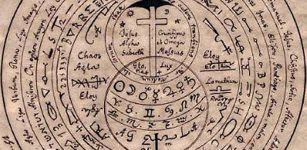 Magical Manuscripts With Thousands Of Ancient Spells Discovered In Germany
Archaeology | Aug 28, 2017
Magical Manuscripts With Thousands Of Ancient Spells Discovered In Germany
Archaeology | Aug 28, 2017 -
 Unusual 2,500-Year-Old Face Urns Reveal Garments, Appearance And Jewelry Of Prehistoric People
Archaeology | Nov 11, 2017
Unusual 2,500-Year-Old Face Urns Reveal Garments, Appearance And Jewelry Of Prehistoric People
Archaeology | Nov 11, 2017 -
 Intriguing Ket People – The Last Nomadic Hunter-Gatherers Of Siberia
Featured Stories | Nov 23, 2023
Intriguing Ket People – The Last Nomadic Hunter-Gatherers Of Siberia
Featured Stories | Nov 23, 2023 -
 Mystery Of Nebra Sky Disk: New Analysis Shows Surprising Results
Artifacts | Sep 4, 2020
Mystery Of Nebra Sky Disk: New Analysis Shows Surprising Results
Artifacts | Sep 4, 2020 -
 Mystery Of Ancient Beehive Tombs Around The World
Featured Stories | Feb 28, 2016
Mystery Of Ancient Beehive Tombs Around The World
Featured Stories | Feb 28, 2016 -
 Mysterious Inca Citadel With Platforms, Passages And Walls Discovered In Peru’s Rainforest
Archaeology | Oct 15, 2017
Mysterious Inca Citadel With Platforms, Passages And Walls Discovered In Peru’s Rainforest
Archaeology | Oct 15, 2017 -
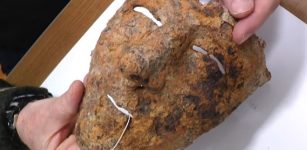 Extremely Rare Roman Cavalry Parade Mask Discovered In Romania
Archaeology | Feb 8, 2023
Extremely Rare Roman Cavalry Parade Mask Discovered In Romania
Archaeology | Feb 8, 2023 -
 On This Day In History: National Foundation Day Celebrated In Japan – On Feb 11, 660 AD
News | Feb 11, 2017
On This Day In History: National Foundation Day Celebrated In Japan – On Feb 11, 660 AD
News | Feb 11, 2017 -
 Robert Fortune’s Dangerous Mission To Obtain Tea From The Chinese
Featured Stories | Feb 24, 2020
Robert Fortune’s Dangerous Mission To Obtain Tea From The Chinese
Featured Stories | Feb 24, 2020 -
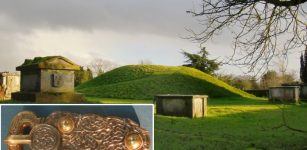 These Curious Burials Could Challenge Historians’ Ideas About Anglo-Saxon Gender
Featured Stories | Oct 3, 2023
These Curious Burials Could Challenge Historians’ Ideas About Anglo-Saxon Gender
Featured Stories | Oct 3, 2023 -
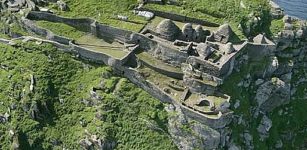 Magnificent Skellig Michael And A 1,400-Year Old Christian Monastery
Featured Stories | Feb 8, 2016
Magnificent Skellig Michael And A 1,400-Year Old Christian Monastery
Featured Stories | Feb 8, 2016 -
 Ancient Entrance Gate Found In Biblical City Of Bethsaida (Zer) Where Jesus Performed His Deeds Of Power
Archaeology | Jul 11, 2018
Ancient Entrance Gate Found In Biblical City Of Bethsaida (Zer) Where Jesus Performed His Deeds Of Power
Archaeology | Jul 11, 2018 -
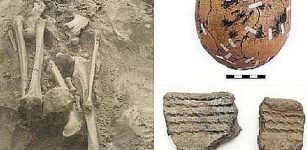 Eastern Baltic’s Communities Of First Farmers And Hunter-Gatherers Merged Slowly
Archaeology | Dec 10, 2023
Eastern Baltic’s Communities Of First Farmers And Hunter-Gatherers Merged Slowly
Archaeology | Dec 10, 2023 -
 Countless Artifacts, Structures And Roads Discovered In Ancient City Of Aigai, Turkey
Archaeology | May 16, 2022
Countless Artifacts, Structures And Roads Discovered In Ancient City Of Aigai, Turkey
Archaeology | May 16, 2022 -
 Human DNA Shaped By Past Events Caused Sharp Dips In The Population
News | Jun 27, 2022
Human DNA Shaped By Past Events Caused Sharp Dips In The Population
News | Jun 27, 2022 -
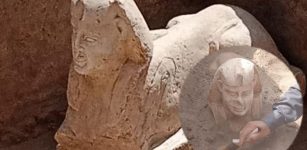 Sphinx Statue With A Smiley Face And Two Dimples Unearthed In Qena, Egypt
Archaeology | Mar 6, 2023
Sphinx Statue With A Smiley Face And Two Dimples Unearthed In Qena, Egypt
Archaeology | Mar 6, 2023 -
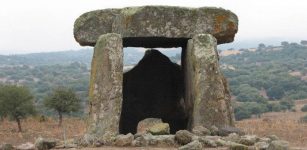 Ancient Secrets Of Megaliths And Anti-Gravity Revealed – Examination Of An Unknown Property Of Static Electricity
Ancient Technology | Feb 17, 2020
Ancient Secrets Of Megaliths And Anti-Gravity Revealed – Examination Of An Unknown Property Of Static Electricity
Ancient Technology | Feb 17, 2020 -
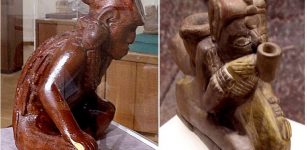 Unsolved Prehistoric Enigma Of Sophisticated Spiro People And Their Mysterious Mounds
Civilizations | Oct 25, 2018
Unsolved Prehistoric Enigma Of Sophisticated Spiro People And Their Mysterious Mounds
Civilizations | Oct 25, 2018 -
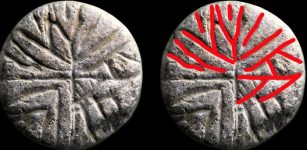 Playing Piece With Runic Inscription Found In Trondheim
Archaeology | Jun 20, 2023
Playing Piece With Runic Inscription Found In Trondheim
Archaeology | Jun 20, 2023

![Tiglath-Pileser III besieging a town named U[pa?], possibly in Turkey.](https://www.ancientpages.com/wp-content/uploads/2019/05/iglathPileser32.jpg)